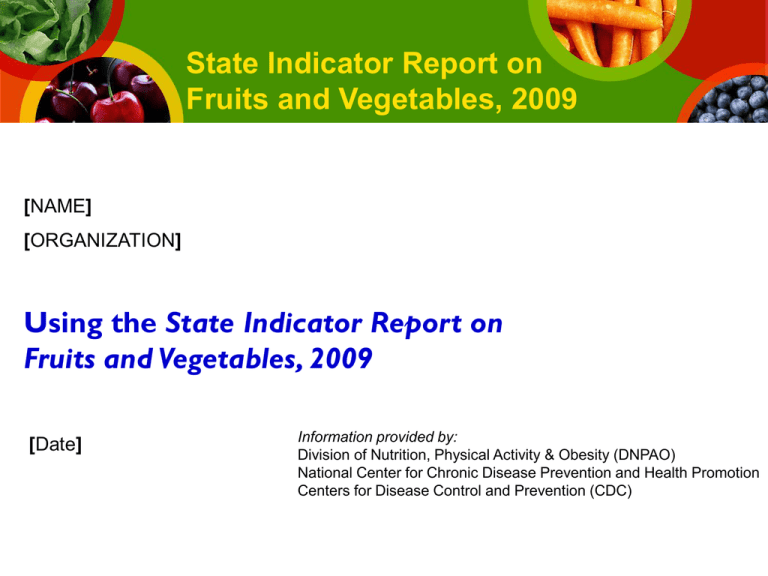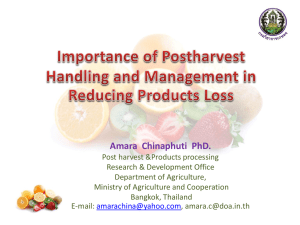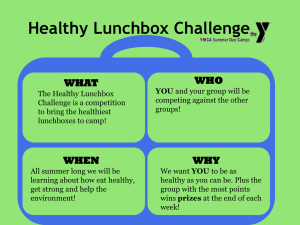State Indicator Report on Fruits and Vegetables, 2009
advertisement

State Indicator Report on Fruits and Vegetables, 2009 [NAME] [ORGANIZATION] Using the State Indicator Report on Fruits and Vegetables, 2009 [Date] Information provided by: Division of Nutrition, Physical Activity & Obesity (DNPAO) National Center for Chronic Disease Prevention and Health Promotion Centers for Disease Control and Prevention (CDC) Presentation Outline • Background Why fruits and vegetables Development of Report • Describe purpose of State Indicator Report on Fruits and Vegetables, 2009 • Present key components and data Behavioral indicators Policy and environmental indicators • Describe application of the Indicator Report – Call to Action 2 Why focus on Fruits and Vegetables? Fruits and vegetables (F&V), as part of a healthy diet, are important for: • • Optimal child growth Weight management F&V have a protective role in: • • • • • Diabetes Heart disease Stroke Some cancers Hypertension Source: http://www.health.gov/DietaryGuidelines/dga2005/document/ 3 State Indicator Report on Fruits and Vegetables State Indicator Report on Fruits and Vegetables, 2009 can be used: • As a surveillance tool, part of state’s surveillance plan • Identify current successes & opportunities for growth and improvement in environmental and policy supports for making F&V more available and affordable within the state • Provide data for advocacy for change 4 Approaches for increasing supportive environments for F&V Socioecological (SE) Model • Physical environment •Schools •Communities • Macro-level environments •Policy actions •Land use Story, M., K. M. Kaphingst, et al. (2008). "Creating healthy food and eating environments: policy and environmental approaches." Annual Rev Public Health 29: 253-72, Figure 1. 5 State Indicator Report on Fruits and Vegetables Reports information for each state on two categories of indicators. • • Reports information for each state on two categories of indicators. • The policy and environmental indicators measure elements of supportive policies and environments for F&V consumption. • The indicators show where a state has been successful in supporting the F&V target area and where more work is needed. • CDC plans publish to regularly throughout decade The behavioral indicators profile the extent to which a state’s population is meeting Healthy People 2010 Fruit and Vegetable objectives. • Inform, Influence, and Monitor Change 6 State Indicator Report on Fruits and Vegetables • [Insert state indicators, or data to augment Indicator Report information] 7 Development of the State Indicator Report on Fruits and Vegetables Criteria for inclusion of an indicator included: • Promising area within the physical and macro-level environments of socioecological model approach for F&V • Data measurable and available for most states, e.g. BRFSS as the adult dietary data source • Data from reputable source • Transparent methodology in obtaining information CDC received feedback from partners • ASTPHND, State F&V Nutrition Coordinators 8 State Indicator Report on Fruits and Vegetables Behavioral Indicators are derived from Healthy People 2010 Fruit objective and Vegetable objective Monitor the objectives and their targets in our state • Increase the proportion of residents in the state consuming fruit at least two times per day (objective 195, target 75% of residents in the state) • Increase the proportion of residents in the state consuming vegetables at least three times per day (objective 19-6, target 50% of residents in the state) Source: http://www.healthypeople.gov/Document/HTML/Volume2/19Nutrition.h tm 9 Behavioral Indicators Adult fruit and vegetable consumption • Proportion of adult residents in the state consuming fruit at least two times per day (objective 19-5, target 75% of residents in the state) • Proportion of adults residents in the state consuming vegetables at least three times per day (objective 19-6, target 50% of residents in the state) • Proportion of adult residents in the state consuming fruit at least two times per day and consuming vegetables at least three times per day (both objectives) • State source for monitoring Healthy People 2010 Fruit and Vegetable Objectives – Behavioral Risk Factor Surveillance System (BRFSS 2007, Odd year data collection) 10 Behavioral Indicators Youth fruit and vegetable consumption • Proportion of adolescent residents in the state consuming fruit at least two times per day (objective 19-5, target 75% of residents in the state) • Proportion of adolescent residents in the state consuming vegetables at least three times per day (objective 19-6, target 50% of residents in the state) • Proportion of adolescent residents in the state consuming fruit at least two times per day and consuming vegetables at least three times per day (both objectives) • Source: Youth Risk Behavior Surveillance System (YRBSS 2007, odd year data collection, grades 9-12) 11 Summary of Behavioral Indicators Among Adults [State] Fruit and Vegetable Daily Frequency 100 US National State Percentage Prevalence 75 50 32.8 25 27.4 Note: Change your state percentage! 14.0 • Double-click on the graph to open the datasheet. If that doesn't bring up the datasheet, right click on the plot area (white background), and select “datasheet”). • Type your state name in the cell entitled “State Percentage”. 0 • Replace the "100"s in the state data with your actual state data. • Do not change the≥HP2010 numbers as these≥ are a reference to the objectives. 2 Fruit 3 providing Vegetable ≥ HP2010 2 Fruit &≥3 • Close out of the datasheet. The bar chart should now reflect your state data. 12 Vegetable •Delete this text box (but not the slide number box)! Summary of Behavioral Indicators Among Adolescents [State] Fruit and Vegetable Daily Frequency 100 US National State Percentage Prevalence 75 50 32.2 25 13.2 Note: Change your state percentage! 9.5 • Double-click on the graph to open the datasheet. If that doesn't bring up the datasheet, right click on the plot area (white background), and select “datasheet”). 0 your state name in the cell entitled “State Percentage”. • Type • Replace the "100"s in the state data with your actual state data. 2 Fruit 3providing Vegetable 2 Fruit &≥3 • Do not change the≥HP2010 numbers as these≥ are a reference to the≥HP2010 objectives. • Close out of the datasheet. The bar chart should now reflect your state data. Vegetable 13 •Delete this text box (but not the slide number box)! State Indicator Report on Fruits and Vegetables Policy and environmental indicators • Represent three different types of strategies to support F&V: Availability of healthier food retail in communities Availability of healthier foods & nutrition services in schools Food systems support 14 Policy and environmental indicators Availability of Healthier Food Retail in Communities • % of census tracts that have healthier food retailers located within the tract or within 1/2 mile of tract boundaries Supermarkets, larger grocery stores, fruit and vegetable markets, warehouse clubs • Policy for healthier food retail, 2001-2009 [y/n] Policies that support building of new food outlets; renovations of existing outlets; increases in & promotion of healthier foods Financial incentives (e.g. grants, loans, tax credits) Technical assistance • Sources: Commercial retail establishment data – Dun & Bradstreet November 2007; US Census Bureau 2000; Legislative databases (DNPAO 2001-2008, NCSL 2004-2009) 15 Policy and environmental indicators Availability of Healthier Food Retail in Communities (cont) • Farmers markets per 100,000 state residents • % of farmers markets that accept electronic benefits transfer (EBT) • % of farmers markets that accept WIC Farmers Market Nutrition Program coupons • Source: USDA Agricultural Marketing Services 2009; U.S. Census Bureau 2008 16 Summary of policy and environmental indicators • Availability of healthier food retail in communities % census tracts Nationally: 72% Range across states: 56% – 84% [STATE]: X% 8 states have supportive state-level policies for healthier food retail [STATE]: [Yes/No] 17 Summary of policy and environmental indicators • Availability of healthier food retail in communities (cont) Farmers market availability Nationally: 1.7 / 100,000 Range across states: 0.2 – 10.5 / 100,000 [STATE]: X/100,000 % Farmers markets that accept EBT Nationally: 7.6% Range across states: 0-50% [STATE]: X% % Farmers markets that accept WIC FMNP Nationally: 28.2% Range across states: 0-94% [STATE]: X% 18 Policy and environmental indicators Availability of Healthier Foods and Nutrition Services in Schools • % of middle and high schools that offer fruits (not juice) and non-fried vegetables as competitive foods Fruits (not juice) & non-fried vegetables are offered to middle and high school students when other food is offered or sold • Policy for Farm to School, 2001-2009 [y/n] Legislative policies that support any component of a Farm to School program (e.g. school or district procurement of local produce, school gardens, staff training) • Sources: CDC School Health Profiles survey 2008; legislative databases (DNPAO 2001-2008, NCSL 2004-2009) 19 Summary of policy and environmental indicators • Availability of healthier foods and nutrition services in schools % of middle and high schools that offer fruits (not juice) and non-fried vegetables as competitive foods Average percentage across participating states: 21% Range across participating states: 0-39% [STATE]: X% 21 states have state-level policies for Farm to School [STATE]: [Yes/No] 20 Policy and environmental indicators Food System Support • % of cropland acreage harvested for fruits and vegetables Of the total land in the state that is harvested for crops, the % that is used for fruits and vegetables • State-level Food Policy Council [y/n] • Number of local Food Policy Councils • Sources: USDA NASS 2007; Community Food Security Coalition 2009 21 Summary of policy and environmental indicators • Food system support % of cropland harvested for fruits and vegetables Nationally: 2.5% Range across states: 0-42.9% [STATE]: X% 20 states have state-level Food Policy Councils [STATE]: [Yes/No] 59 local Food Policy Councils across the country Range across states: 0-14 [STATE]: X local councils 22 State Indicator Report on Fruits and Vegetables – Call to Action • Incorporate into state plan Surveillance Priority strategies • • • • • Advocate for improvement Evaluate progress over time Identify success stories Broaden community support for F&V Strengthen policy action and support 23 State Indicator Report on Fruits and Vegetables – Call to Action Availability of Healthier Food Retail – Potential Action Steps • Provide financial and nonfinancial incentives to food retailers1,2 • Provide support for farmers markets to purchase wireless electronic benefit transfer (EBT) devices – SNAP & WIC2 • Engage in outreach and education to residents of lower-income neighborhoods and SNAP and WIC recipients in communities where farmers markets, stands, and other venues accept benefits2 • Improve zoning and transportation policies – retail accessibility2 1Keener 2 D, 2009 IOM, 2009 24 State Indicator Report on Fruits and Vegetables – Call to Action Availability of Healthier Food Retail – Resources • Policy Link tool for improving access to healthy food in underserved communities: http://www.policylink.org/site/c.lkIXLbMNJrE/b.5137405/k.604 2/Healthy_Food_Retailing.htm • Planning for Healthy Places provides Model General Plan Language to Protect and Expand Farmers Markets: http://www.healthyplanning.org/modelpolicies.html • Leadership for Healthy Communities Action Strategies Toolkit is a guide to create healthy communities and prevent childhood obesity: http://www.rwjf.org/files/research/20090508lhcactionstrategies toolkit.pdf • The National Policy & Legal Analysis Network to Prevent Childhood Obesity (NPLAN) provides model policies, fact sheets, toolkits, on various topics related to obesity and public health: http://nplanonline.org/ 25 State Indicator Report on Fruits and Vegetables – Call to Action Availability of Healthier Foods and Nutrition Services in Schools – Potential Action Steps • Establish nutrition standards for competitive foods as part of school wellness policies.3 • Monitor and evaluate the implementation and enforcement of nutrition standards.3 • Support Farm-to-School initiatives.1 1Keener 3 D, 2009 IOM, 2007 26 State Indicator Report on Fruits and Vegetables – Call to Action Availability of Healthier Foods and Nutrition Services in Schools – Resources • • National Farm to School: http://www.farmtoschool.org/ • CDC resource on Local Wellness Policy Tools & Resources for school setting: http://www.cdc.gov/HealthyYouth/healthtopics/wellness.htm Council of State Governments, School Wellness Policies, Legislator Policy Brief: www.healthystates.csg.org/NR/rdonlyres/C87EB28D-B2F64399-B1BD-BC5617940019/0/SchoolWellnessPoliciesFINAL.pdf 27 State Indicator Report on Fruits and Vegetables – Call to Action Food System Support – Potential Action Steps • • 1 Organize a Food Policy Council or Coalition.1 Adopt supportive policies for production, distribution, or procurement from local farms.1 Keener D, 2009. 28 State Indicator Report on Fruits and Vegetables – Call to Action Food System Support – Resources • Building local food systems: A planning guide. Center for Popular Research, Education and Policy and New York Sustainable Agriculture Working Group, 2006. http://www.nysawg.org/pdf/Local_Food_Planning_Guide_v2.pdf • The North American Food Policy Council site: http://www.foodsecurity.org/FPC/ 29 State Indicator Report on Fruits and Vegetables – Call to Action Action References 1. Keener, D., Goodman, K., Lowry, A., Zaro, S., & Kettel Khan, L. (2009). Recommended community strategies and measurements to prevent obesity in the United States: Implementation and measurement guide. Atlanta, GA: U.S. Department of Health and Human Services, Centers for Disease Control and Prevention. http://www.cdc.gov/obesity/downloads/community_strategies_gui de.pdf 2. IOM (Institute of Medicine). 2009. Local Government Actions to Prevent Childhood Obesity. Washington, DC: The National Academies Press. http://www.iom.edu/Object.File/Master/72/800/local%20govts%2 0obesity%20report%20brief%20FINAL%20for%20web.pdf 3. IOM (Institute of Medicine). 2007. Nutrition Standards for Foods in Schools: Leading the Way Toward Healthier Youth. Washington, DC: The National Academies Press. http://www.iom.edu/CMS/3788/30181/42502.aspx 30 State Indicator Report on Fruits and Vegetables – Call to Action • General Resources State Indicator Report on Fruits and Vegetables, 2009 http://www.fruitsandveggiesmatter.gov/indicatorreport National and state by state data, data sources, references Maps National Action Guide CDC Division of Nutrition, Physical Activity, and Obesity website http://www.cdc.gov/nccdphp/dnpao/ CDC is part of the National Fruit and Vegetable Program (http://www.fruitsandveggiesmatter.gov) Goal: increase F&V consumption for improved public health Tools, recipes, and other resources 31 State Indicator Report on Fruits and Vegetables – Call to Action • [STATE] Resources [Add applicable state resources here] • [STATE] Partners [Add applicable state partners here] • Create awareness among… [Add applicable groups] 32 State Indicator Report on Fruits and Vegetables – Next Steps • Discussion of next steps • [Fill in points for discussion] 33 [STATE] Contact Information [NAME] [e-mail] [phone] CDC Contact Information indicator_reportfv@cdc.gov • Technical assistance • Feedback and general questions The State Indicator Report on Fruits and Vegetables, 2009 http://www.fruitsandveggiesmatter.gov/indicatorreport Division of Nutrition, Physical Activity, and Obesity http://www.cdc.gov/nccdphp/dnpao/index.html 34






